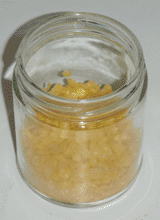
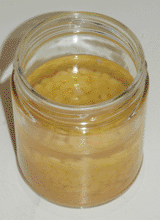
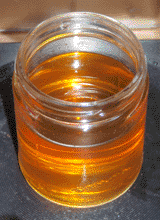
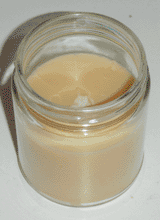
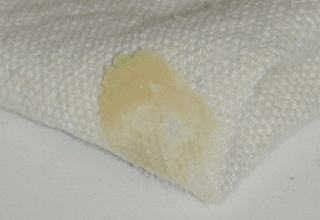
Wax is by far the simplest wood finish, being applied just by rubbing and buffing. However, applying solid wax in this way requires significant effort, since the wax needs to be softened by friction. This vigorous buffing can also be dangerous, if the wood has sharp edges or tends to splinter. An easier method is to dissolve the wax into a solvent to make a paste, so that the softening is achieved by chemical, rather than physical means. In particular, I've found beeswax and carnauba wax to be the most useful waxes for this purpose, and turpentine to be the most useful solvent. These two waxes provide a range of complementary characteristics and can be blended in any proportion, resulting in a highly adjustable surface finish. A comparison of their properties can be seen below.
| Beeswax | Carnauba Wax | |
|---|---|---|
| Source | Honeycomb | Palm Leaves |
| Melting Point | Low (60°C) | High (80°C) |
| Friction | High (Rubbery) | Low (Glassy) |
| Flexibility | High (Malleable) | Low (Brittle) |
| Water Resistance | Good | Excellent |
In the context of woodworking, both of these waxes have benefits and disadvantages. Beeswax is easily applicable in paste form, but the residual friction is undesirable. Carnauba wax gives a slick surface, but tends to leave behind a white powder in any crevices in the wood. Fortunately, the two waxes can be combined into a single paste, which balances their characteristics and is suitable as a general purpose wood finish.
To make such a paste, I began by adding 25g of beeswax and 25g of carnauba wax to a small jar, to which I then added 100g of turpentine. Experimentally, I found that beeswax requires its own weight of turpentine to make a spreadable paste, and carnauba wax three times its weight; accordingly, blends of the two waxes fall proportionally between these limits. I then carefully heated this mixture to 80°C on a hot plate (although in hindsight, a double boiler would have been preferable), at which point the carnauba wax melted and went into solution. I then removed the jar from the heat and allowed it to cool to room temperature. The steps of this process can be seen at the top of the page. The resulting paste was easily spreadable with a rag, and could quickly be buffed onto a piece of wood. The resulting surface had relatively low friction, a good shine, and the paste wax left no powdery residue.
Despite the ease of application, any wax finish has the serious limitation that it does not provide any mechanical protection to the wood. Waxed surfaces are only marginally superior to raw wood, and any benefit comes primarily from giving the wood a smoother, more easily cleanable surface. However, I have found that this type of paste wax is indispensable as a surface modifier for my rosin varnish. When paste wax is applied to a varnished surface, the turpentine in the paste partially dissolves the rosin, so that the wax becomes part of the varnish itself. This imparts significant water resistance to the otherwise vulnerable surface, and in practice this enables the varnish to be used on objects that are regularly exposed to water. Furthermore, varnish which has been damaged by water can be repaired by paste wax, which restores its gloss. This type of dual finish shows surprising weather resistance, and it has quickly become a staple of my woodworking methods.
After some experimentation, I have found that castor wax (hydrogenated castor oil) is a potentially superior base material for this type of finish. It has a melting point of 90°C, yet is 1/3 the cost of carnauba wax. It is also much softer in paste form, being spreadable when combined with just twice its weight of turpentine, and it has a much longer working time as well. Most importantly however, the finish it produces is incredibly brilliant, capable of showing mirror-like reflections even on fairly rough wood surfaces. The wax is also fairly transparent, so it does not tend to leave white spots inside crevices or when applied thickly. The only questionable aspect is its longevity, as it is a type of fat rather than a true wax; however, a sample left exposed to the weather for multiple weeks has shown no change whatsoever, so this might not be an issue. I intend to use this new material in upcoming projects to more accurately assess its performance.
EDIT: 8/23/2020While castor wax and carnauba wax are useful as additives to produce a very hard surface, I have found that the most versatile paste wax is made simply from one part of white beeswax and two parts of turpentine. White beeswax is somewhat less rubbery than ordinary yellow wax, yet still soft enough to be used on flexible surfaces such as leather and paper. I have recorded a video that demonstrates the preparation of this particular formula, which can be seen below.
EDIT: 5/21/2025Though paste wax should naturally consist primarily of wax, I have found that other additives may be used to modify its properties. For example, small amounts of resin (either rosin or dammar) may be added to improve the shine of the surface, though an excessive amount will cause tackiness. Drying oils (e.g. tung or linseed) may be added as well, either to soften hard waxes during polishing, or as a replacement for turpentine to make a solvent-free non-shrinking wax, useful for filling porous grain on wood. This greatly slows the drying time, however. Similarly, non-drying oils (e.g. olive or castor) may be added to wax polishes for leather, although it could be argued that this is actually a type of grease. Combinations of wax, resin, and oil may even be created, but this then becomes such a broad range of materials that it would be difficult to classify, and is best left as an exercise to the reader.
Ultimately though, beeswax and turpentine still remain the most versatile combination of materials. These can be mixed in nearly any ratio depending on the desired method of application; thick pastes wipe on easily and fill grain quickly, while thin pastes may even be applied with a paintbrush. The polishing process can likewise be achieved by nearly any means. For smooth surfaces a cloth is adequate, while carved or textured wood may be buffed with a scrubbing brush, which I have found to be surprisingly effective for rough work. In general, wax remains the most open-ended wood finish, both in its preparation and application methods.